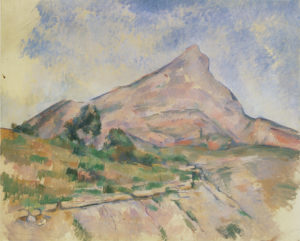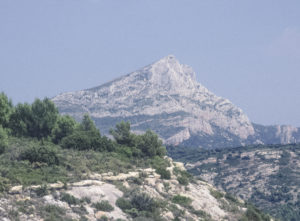R762 – La Montagne Sainte-Victoire vue des Infernets, vers 1895 (FWN295)
Pavel Machotka
(Cliquer sur les images pour les agrandir)
The structure of La Montagne Sainte Victoire vue des Infernets is limited to repeating diagonals, and in the summer its colors are muted and its hillsides parched. Admittedly, the nearby rocky cliff forms a solid base for the peak above and its two slopes echo the mountain’s own; both slopes are long and gentle on the left and short and sharp on the right. Cézanne has gone out of his way to stand this close to the mountain and here he sees its long ridge (visible in its full extension in La Sainte-Victoire vue du Pont de Bayeux à Meyreuil) compressed into mere protrusions, the near one towering over the far one. Perhaps in response to this unusual profile he elongated the mountain further: on his canvas it rises higher than in reality. Whether Cézanne opted for a thrusting effect, which he focused on the expressive squiggle, or responded with momentary disorientation to the novelty of this view, will never be known.
He has, in any case, balanced the sharpness of the mountain’s outline with a gentleness of color. Painting possibly later in the season than the mid-summer photograph — with the ground cover yellowing and the sun lower and warmer — he has balanced the warm and cool colors more finely, and even allowed the pale yellow of the canvas sizing to push the balance further. With all this said, however, the painting remains listless; it is witness to the honesty of acute perception and to making the most of an unpromising view.
Source: Machotka, Landscape into Art




Vous devez être connecté pour poster un commentaire.